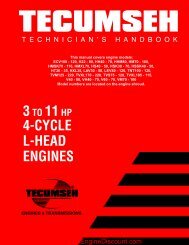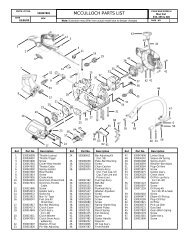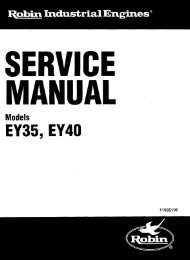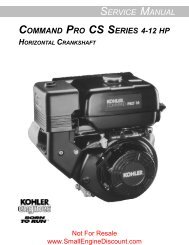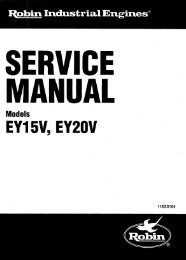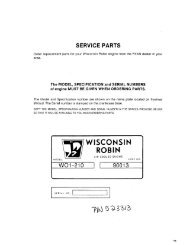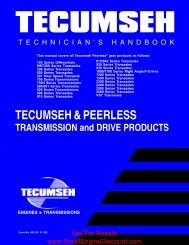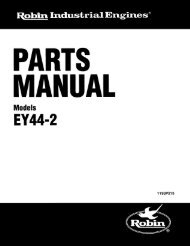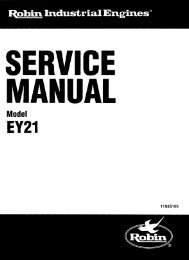4-CYCLE OVERHEAD VALVE ENGINES - Small Engine Discount
4-CYCLE OVERHEAD VALVE ENGINES - Small Engine Discount
4-CYCLE OVERHEAD VALVE ENGINES - Small Engine Discount
You also want an ePaper? Increase the reach of your titles
YUMPU automatically turns print PDFs into web optimized ePapers that Google loves.
TESTING<br />
12<br />
1. After repeated efforts to start the engine using the procedure listed in the operator’s manual fail, check<br />
for spark by removing the high tension lead and removing the spark plug. Install a commercially available<br />
spark tester and check for spark. If the spark is bright blue and consistent, proceed to step 2. If no or<br />
irregular spark see Chapter 8 under "Testing".<br />
2. Visually inspect the removed spark plug for a wet condition indicating the presence of gasoline in the<br />
cylinder.<br />
STANDARD<br />
OHV<br />
NOTE: Check plug for correct reach (diag.<br />
PLUG<br />
17).<br />
3. If the spark plug is dry, check for restrictions<br />
in the fuel system before the carburetor. If the<br />
spark plug is wet, continue with step # 7.<br />
CHECK THE FUEL CAP FOR PROPER<br />
VENTING. With a proper draining receptacle,<br />
remove the fuel line clamp on the carburetor<br />
fuel inlet and pull the fuel line off the fitting.<br />
Examine the fuel flow with the fuel cap both<br />
on and off the fuel tank.<br />
CAUTION: DRAIN THE FUEL INTO AN<br />
APPROVED CONTAINER OUTDOORS, AND AWAY FROM ANY OPEN FLAME OR COMBUSTION<br />
SOURCE. BE SURE THE ENGINE IS COOL.<br />
NOTE: Todays fuels can cause many problems in an engines performance, due to the fuels quality<br />
and short shelf life. Always check fuel as a primary cause of engine performance.<br />
4. Remove the air filter, heater box, or air cleaner assembly if applicable to visually check that the choke<br />
shutter completely closes or check to see if fuel comes out of the main nozzle during priming.<br />
5. If the fuel flow from the tank is adequate and no fuel is evident during priming, the carburetor will need<br />
to be removed for service. See “Service” in this chapter or consult the “Carburetion Troubleshooting”<br />
chart to diagnose carburetor symptoms. Improper fuel flow indicates the fuel, fuel line, filter or tank<br />
require cleaning or replacement.<br />
6. Check the engine compression using a commercially available compression tester and follow the<br />
tester’s recommended procedure. Low compression, a dry spark plug, adequate fuel flow, and a known<br />
good functional carburetor indicates an internal engine problem exists. See Chapter 9 under<br />
“Troubleshooting.”<br />
7. A wet spark plug indicates fuel is being supplied by the carburetor. The engine may be flooded by<br />
a restricted air filter, carbon shorted or defective spark plug, excessive choking or over priming,<br />
improperly adjusted or defective carburetor. With the spark plug removed and a shop towel over<br />
the spark plug hole, turn the engine over slowly 3 or 4 times to remove excess gasoline from the<br />
engine cylinder.<br />
CAUTION: KEEP ALL COMBUSTIVE SOURCES AWAY. AVOID THE SPRAY FROM THE SPARK<br />
PLUG HOLE WHEN CRANKING THE ENGINE OVER.<br />
8. Replace the air filter if restricted or oil soaked. Replace the spark plug if questionable. Install the spark<br />
plug and high tension lead and try to start the engine.<br />
9. If the engine floods and fails to start, the carburetor will require service. See the proceeding “Carburetion<br />
Troubleshooting” chart for additional causes. If the carburetor is functioning properly the problem may<br />
be ignition timing related. See Chapter 8 “Ignition” under “Troubleshooting.”<br />
SERVICE<br />
Carburetor Pre-sets and Adjustments<br />
Before adjusting any mixture screws the necessary carburetor presets should be made. Check for the proper<br />
governor adjustments as outlined in Chapter 4. Identify the correct carburetor model and manufacturer to find<br />
locations of the high and low speed adjustment screws. Check the throttle control bracket for proper adjustment<br />
allowing a full choke shutter position. See Chapter 4 under "Speed Controls and Linkage". Check to see if the<br />
normal maintenance procedures have been performed (oil changed, fresh fuel, air filter replaced or clean).<br />
Consult microfiche card #30 to find the correct R.P.M. settings for the engine. Start the engine and allow it to<br />
warm to operating temperature. The carburetor can now be adjusted.<br />
NOTE: RPM SETTINGS CAN ALSO BE FOUND ON THE COMPUTERIZED PARTS LOOK UP SYSTEMS.<br />
Not For Resale<br />
www.<strong>Small</strong><strong>Engine</strong><strong>Discount</strong>.com<br />
17




